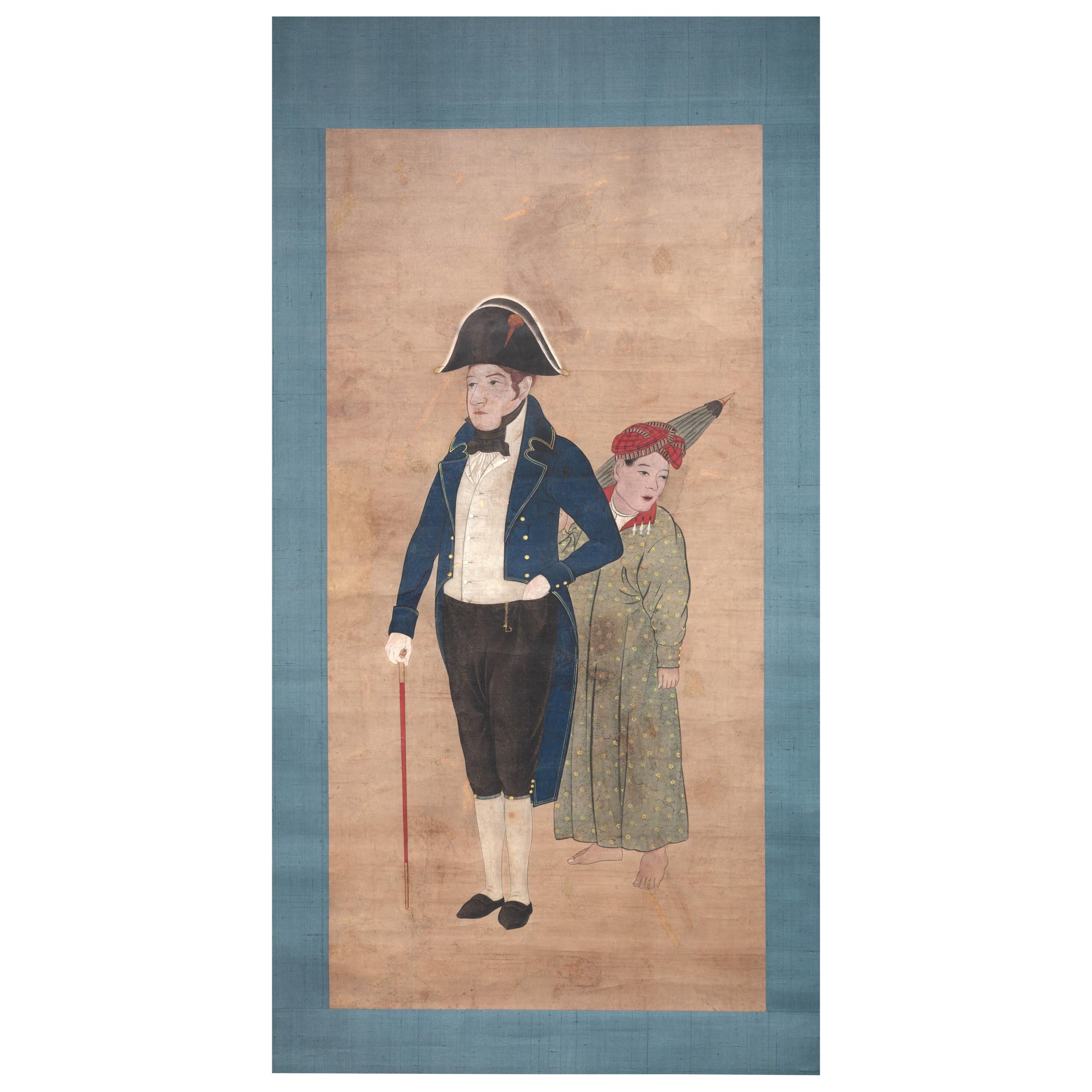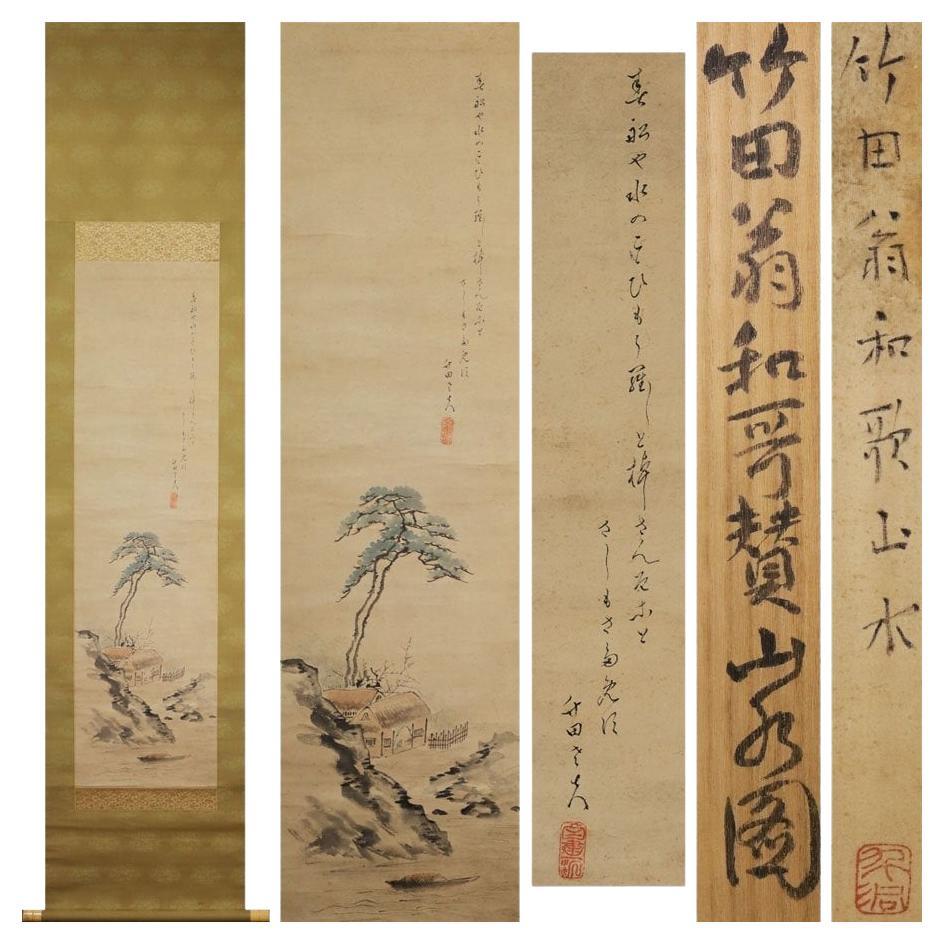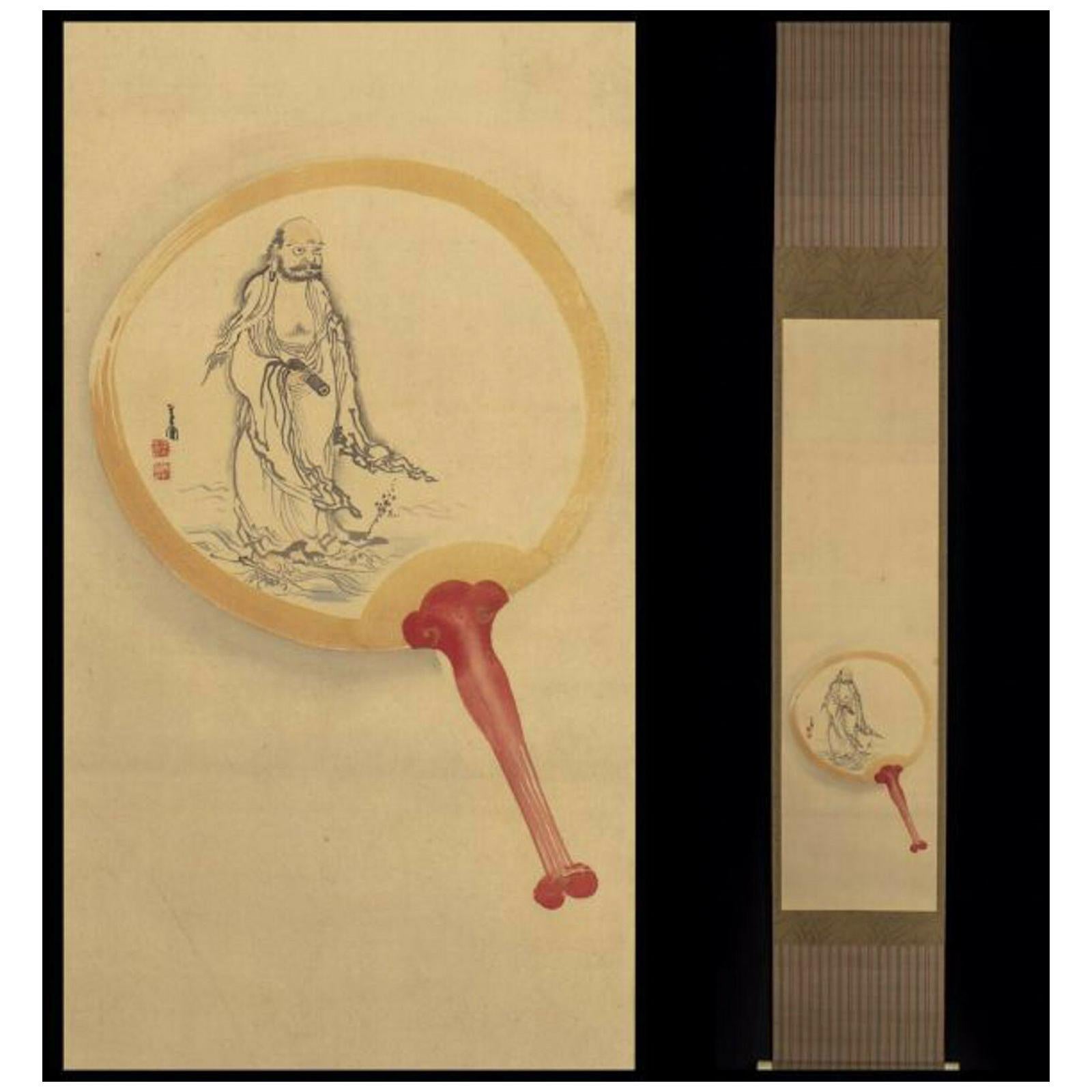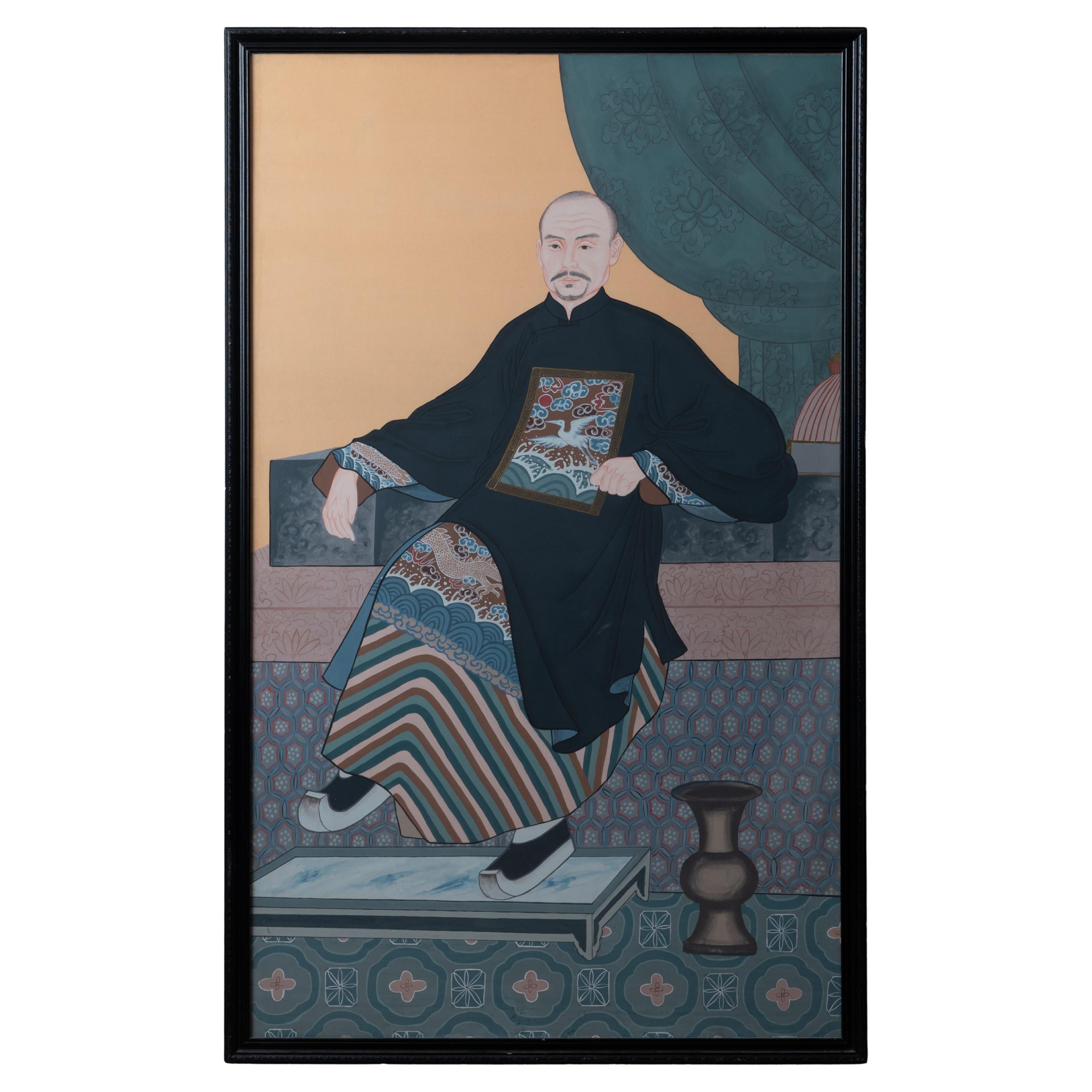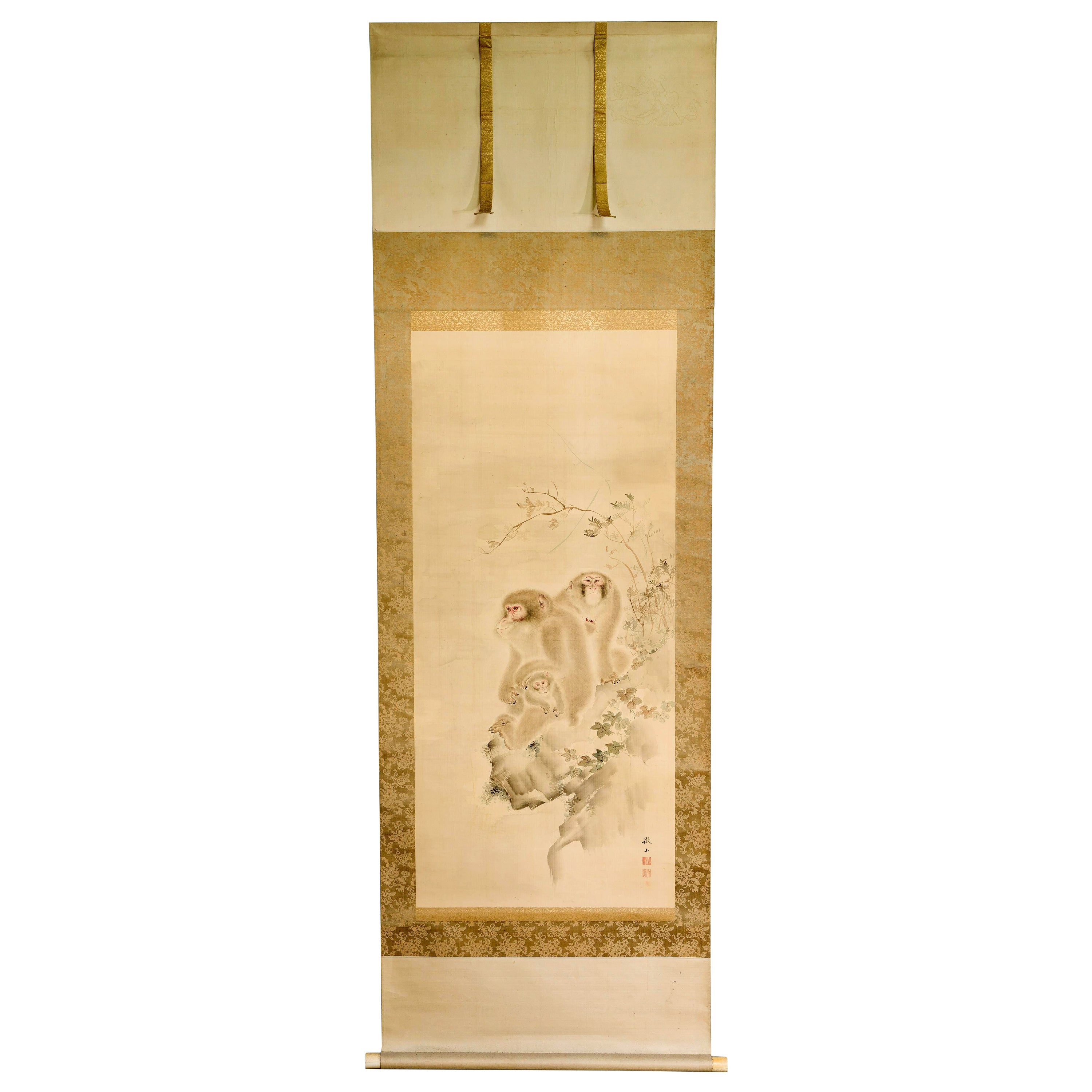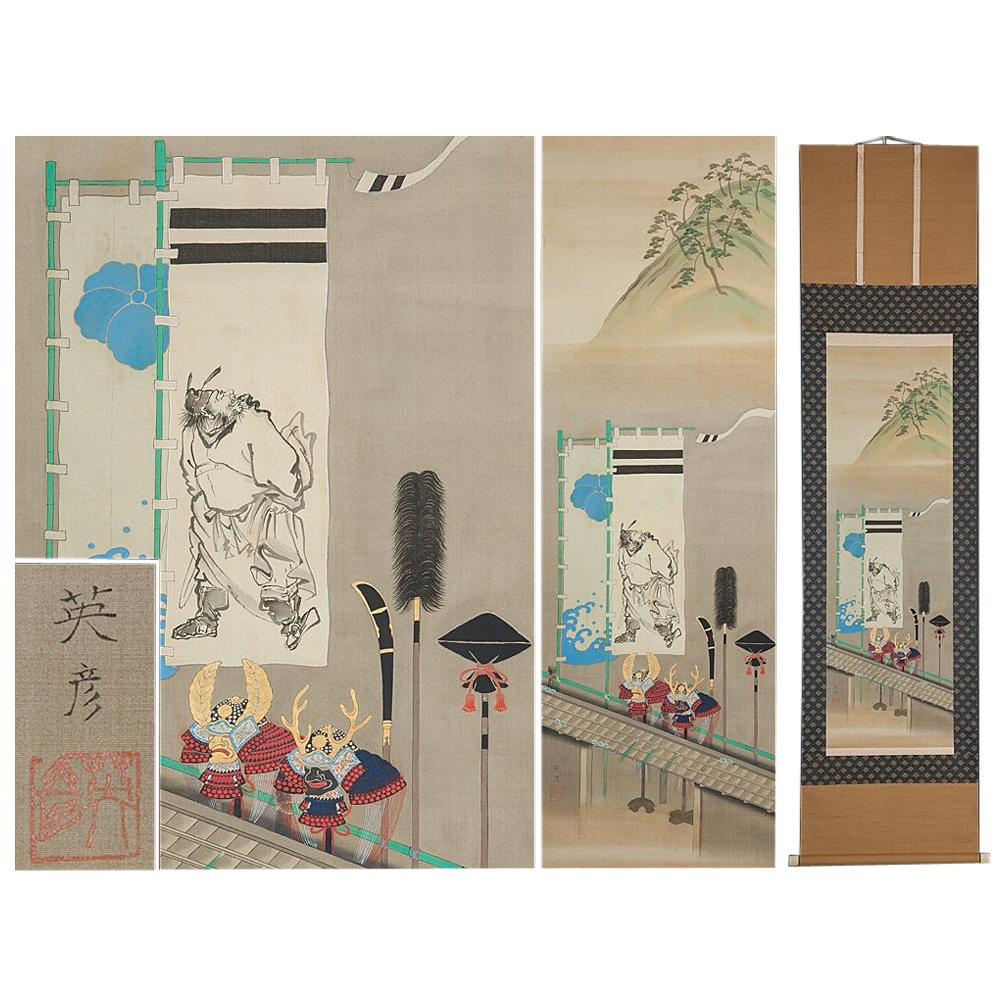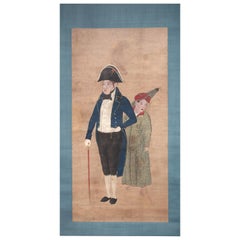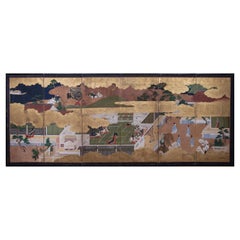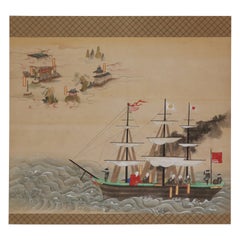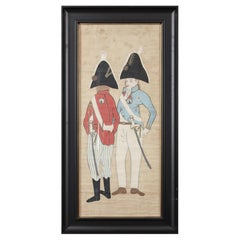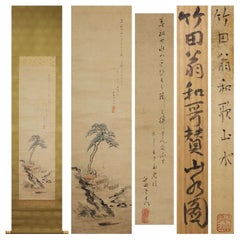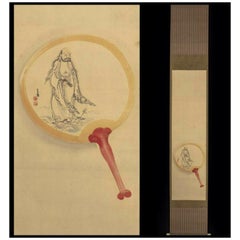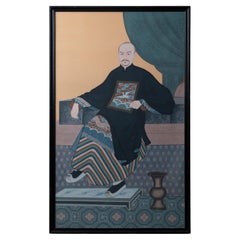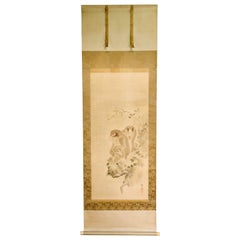Items Similar to Japanese Scroll Painting of Diplomat Takeaki Enomoto, Meiji, Late 19th Century
Want more images or videos?
Request additional images or videos from the seller
1 of 2
Japanese Scroll Painting of Diplomat Takeaki Enomoto, Meiji, Late 19th Century
$83,870.05
£62,435.80
€70,000
CA$114,881
A$127,772.75
CHF 66,718.96
MX$1,554,858.48
NOK 852,102.94
SEK 799,122.23
DKK 532,885.56
Shipping
Retrieving quote...The 1stDibs Promise:
Authenticity Guarantee,
Money-Back Guarantee,
24-Hour Cancellation
About the Item
Anonymous Japanese painter (MEIJI PERIOD, LATE 19TH CENTURY)
Portrait of Takeaki Enomoto (1836-1908)
Ink, color and go fun on silk, framed.
Painting: 79.5 x 50 cm
With frame: 103.5 x 64.5 cm
Note:
Takeaki Enomoto, a Meiji government official, is painted in very fine detail standing next to a Chinese style table upon which a globe, painted in white gofun and a book bearing a coat of arms. He is wearing a western frock coat and holding a cane. Takeaki Enomoto was a ket player in the events which led to the establishment of the Meiji government. He also made a significant contribution to Japan’s relations with the West in the late 19th century. He was born as a lower-ranking samurai, but rose up to hold various important posts in the Edo period government. Enomoto studied Dutch naval science in Nagasaki, which during the Edo period was the only city in which the Dutch on the small artificial island Deshima, were permitted to stay and trade. He then continued his studies in Holland from 1862, and became fluent in Dutch and English. In 1867 he returned to Japan and was appointed to a senior naval post in the Tokugawa bakufu (government). However, in 1868, the Tokugawa bakufu was overthrown by the warlords of Satsuma and Choshu, and the Meiji Emperor was reinstated as the figurehead of a new government.
Enomoto resisted the takeover of the Meiji government by fleeing with eight warships to Ezo (Hokkaido) and establishing a Tokugawa “republic” as the last military stronghold opposing the new regime. In spring 1869 Enomoto surrendered and peace was officially restored to the whole of Japan. When he surrendered Enomoto sent the notes he had made on navigation in Holland to the commander of the army, stating that they would be useful for the country. This conduct impressed the Meiji government and therefore he was imprisoned rather than executed. In 1872 he was pardoned and immediately appointed to office in the government. He was sent to St. Petersburg as a diplomat to negotiate over the ownership of Sakhalin and Kuril islands. He was successful in concluding a treaty giving Sakhalin to Russia but keeping the Kurils for Japan.
His achievement was celebrated as the first in which Japan and a Western power were treated as equals. Enomoto rose to cabinet rank within the Meiji government and his positions included that of the Minister of Agriculture and Commerce. The globe and book here are clear references to Enomoto’s international experience.
The book bears a coat-of-arms with notable similarities to that of Napoleon III (1808- 1870). During Enomoto’s time in the Tokugawa government negotiations between France and the Shogunate began. The first French military mission to Japan, sent by Napoleon III, arrived in 1867. With the mission came Captain Jules Brunet (1838-1911) a military officer who joined the last stand of the Shogunate “republic” in 1868 by fleeing north with Enomoto to Ezo.
- Dimensions:Height: 40.75 in (103.5 cm)Width: 25.4 in (64.5 cm)Depth: 0.79 in (2 cm)
- Style:Meiji (Of the Period)
- Materials and Techniques:
- Place of Origin:
- Period:
- Date of Manufacture:1880-1900
- Condition:Wear consistent with age and use.
- Seller Location:Amsterdam, NL
- Reference Number:1stDibs: LU5458220980532
About the Seller
5.0
Recognized Seller
These prestigious sellers are industry leaders and represent the highest echelon for item quality and design.
Established in 1985
1stDibs seller since 2020
23 sales on 1stDibs
Typical response time: 2 hours
- ShippingRetrieving quote...Shipping from: Amsterdam, Netherlands
- Return Policy
Authenticity Guarantee
In the unlikely event there’s an issue with an item’s authenticity, contact us within 1 year for a full refund. DetailsMoney-Back Guarantee
If your item is not as described, is damaged in transit, or does not arrive, contact us within 7 days for a full refund. Details24-Hour Cancellation
You have a 24-hour grace period in which to reconsider your purchase, with no questions asked.Vetted Professional Sellers
Our world-class sellers must adhere to strict standards for service and quality, maintaining the integrity of our listings.Price-Match Guarantee
If you find that a seller listed the same item for a lower price elsewhere, we’ll match it.Trusted Global Delivery
Our best-in-class carrier network provides specialized shipping options worldwide, including custom delivery.More From This Seller
View AllDutch Colonial Japanese Scroll Painting of Chief Merchant Doeff
Located in Amsterdam, NL
Nagasaki School (EARLY 19TH CENTURY)
Opperhoofd Hendrik Doeff with Javanese servant
Kakemono, watercolor on paper, mounted on silk and textile covered paper scroll, not signed....
Category
Antique Early 19th Century Japanese Edo Paintings and Screens
Materials
Silk, Paper
Important Japanese six-fold screen depicting The Tale of The Genji, 17th century
Located in Amsterdam, NL
An important Japanese six-fold screen, depicting episodes from The Tale of The Genji
Edo period, 17th century
Ink and colour on gilded paper, H. 155 x W. 380 cm
The Tale of Genji...
Category
Antique 17th Century Japanese Edo Paintings and Screens
Materials
Paint, Paper
Japanese Painting Depicting Commodore Perry’s Ship with Buddhist Monks Aboard
Located in Amsterdam, NL
A Japanese painting depicting Commodore Matthew Perry’s flagship USS Mississippi bringing the coffin with the remains of US marine private Robert Williams who died while serving on t...
Category
Antique Mid-19th Century Japanese Edo Paintings and Screens
Materials
Paint, Paper
A Japanese painting depicting two European generals
Located in Amsterdam, NL
Nagasaki, 19th century
H. 98 x W. 41 cm
Provenance:
Private collection, Portugal
Category
Antique 19th Century Japanese Paintings and Screens
Materials
Paper
Five Extremely Rare Chinese Drawings of Foreigners, 18th Century, Colonial
Located in Amsterdam, NL
Five Chinese paintings of western people by an unknown artist
China, circa 1760, captions later
All in giltwood frames.
“A woman with Portuguese hairdo, with gold, silver and gemstone necklace, a skirt under a vest, a koi on her back, called a cloak, a woman customarily inherited the family business, the male humble, to the threshold (Qianlong year, circa 1735).”
Gouache on silk, measures: 32 x 25.4 cm
“He is a Westerner who had a white skin. He does not have a heavy beard but plaits his hair. He wears a triangular black hat, short jacket, leather shoes and long stockings...
Category
Antique Mid-18th Century Chinese Chinese Export Paintings and Screens
Materials
Paper
17th Century Japanese Export Lacquer Cabinet with Depiction the Dutch Tradepost
Located in Amsterdam, NL
A highly important Japanese export lacquer cabinet with depiction of the Dutch East India Company tradepost Deshima and the annual Dutch delegation on its way to the Shogun in Edo
Edo period, circa 1660-1680
H. 88 x W. 100.5 x D. 54 cm
This cabinet includes a later European japanned stand, but also a modern powder-coated steel frame.
The latter can be designed and added to your specific needs.
The sides and front of the rectangular two-door cabinet are embellished in gold and silver hiramaki-e and takamaki-e on a black roiro lacquer ground with a continuous design. The two doors depict a long procession of numerous figures travelling on foot and horseback along buildings and a pagoda into a mountainous landscape. This is the annual court journey, Hofreis, of the Dutch from Nagasaki to the Shogun’s court in Edo. Three horseback riders are dressed as Dutch merchants and a fourth figure, probably het Opperhoofd, is seen inside a palanquin, norimon. Just about to cross the bridge, two men are carrying a cabinet like the present one.
Many Japanese figures on either side of the procession are engaged in various activities; some play musical instruments on board of small boats, others are fishing; figures inside buildings are depicted playing go, and farmers are tending to their rice paddocks. The upper part of the right door shows a large mansion, probably the local daimyo’s castle, with men kneeling before a man in the central courtyard.
The court journey fits in with the foreign policy of the shogunate which accorded a role to the VOC alongside China, Korea, and the Ryukyu Islands who also had to pay tribute. However, the VOC employees were traders, having low status in Japan’s social hierarchy, and they were received with less deference than were the state embassies from Korea and the Ryukyu Islands. Nevertheless, the contacts with the Dutch were a welcome source of information to the Shogun about Europe and European science and technology.
The left side of the cabinet depicts, in mirror image, a rare view of the artificial fan-shaped Deshima Island, the trading post for the Dutch in Japan. The island, where the Dutch flag flies, is surrounded by small Japanese boats and an anchored three-masted fluyt (cargo ship), flying Dutch flags, with on the stern the VOC monogram. On the bottom right a busy street of Nagasaki is shown, bordered by shops and leading up to the stone bridge. On the island the trees are beautifully painted, two cows can be seen, and the flagpole, all in very fine detail. Dutchmen and enslaved Malay are visible outside the buildings and two Japanese figures, probably guards, sit in a small hut in the centre.
A maximum of fifteen to twenty Dutchmen lived on the island at any time and soldiers or women were not allowed. Restrictions on Deshima were tight, and the merchants were only allowed to leave the island by special permission. The Opperhoofd had to be replaced every year, and each new Opperhoofd had to make a court journey to pay tribute, present gifts, and to obtain permission to Margaret Barclay eep on trading. In the distance, many birds fly above the hills and a four-story pagoda can be seen. The right side of the cabinet is painted with other horse riders and their retinue journeying through mountains.
The pair of doors to the front open to reveal ten rectangular drawers. The drawers are decorated with scenes of birds in flight and landscapes with trees and plants. The reverse of the left door with two thatched buildings, one with a ladder, underneath a camelia tree with large blooms; the right door with a three-story pagoda nestled among trees and both doors with a flying phoenix, ho-oo bird. The cabinet, with elaborately engraved gilt copper mounts, hinges, lock plates and brass handles, is raised on an 18th-century English japanned wood stand.
A pair of large cabinets...
Category
Antique 17th Century Japanese Edo Lacquer
Materials
Copper, Gold
$1,497,679
Free Shipping
You May Also Like
Japanese Nihonga Painting 18/19th c Edo Scroll Tanomura Chikuden Self Portrait
Located in Amsterdam, Noord Holland
Tanomura Takeda's handwritten self-portrait hymn "Painted Landscape" with himself working in a hut
Takeda Tanomura and depicts fields and mountains in spring, and is accompanied by a self-written waka poem that is thought to be about the scene.
[Tanomura Takeda]
A painter from Takeda Village, Naoniri District, Bungo Province (present-day Takeda City).
His family was born as the second son of Ken'an, who had been a samurai physician in the Oka domain for generations. He first studied medicine, but preferred learning over medicine, and studied Chinese studies under Kimizan Karahashi, a He also learned painting techniques from Buncho Tani, and after returning to Japan, he served as the president of a domain school.
He resigned his post in 1812 and traveled between Keihan and Osaka, where he interacted with Raizanyo, Shinozaki Kotake, Urakami Gyokudo, Okada Yonezanjin, Unka Shonin, Aoki Mokubei...
Category
Antique 18th Century Edo Paintings
Materials
Silk
$2,202 Sale Price
20% Off
Lovely Japanese 18th-19th Century Edo or Meiji Scroll Painting Japan
Located in Amsterdam, Noord Holland
Maruyama–Shijo style painting
C0ndition; Good but some stains.
Overall dimensions: width of about 28.2 cm and Length of about 173.8 cm
Painting width of about 25.5 cm × leng...
Category
Antique 19th Century Japanese Meiji Paintings and Screens
Materials
Bronze
$670 Sale Price
20% Off
Chinese Gentleman Portrait Painting
Located in Savannah, GA
A gouache on silk portrait of a Chinese gentleman in the manner of Chinnery, 20th Century.
37 ¾ inches wide by 60 ¾ inches tall
Category
20th Century Chinoiserie Paintings
Materials
Silk, Glass, Wood
Japanese Silk Scroll Painting of Moneys Edo Period Mori Tetsuzan
Located in Atlanta, GA
A Japanese mounted vertical hanging scroll painting by Mori Tetsuzan (Japanese, 1775-1841) circa 19th century Edo period. The watercolor and ink on silk ...
Category
Antique 19th Century Japanese Japonisme Paintings and Screens
Materials
Silk, Paper
Lovely Early 20th Century Scroll Paintings Japan Meiji Artist Signed
Located in Amsterdam, Noord Holland
It is a hanging scroll made in the Meiji or Taisho period
Condition: Some stains and age related ware:
¦ Axis ... vertical 200.5cm next to 49.5cm
Painting ... vertical 113.3cm h...
Category
Early 20th Century Japanese Showa Paintings and Screens
Materials
Fabric
$1,102 Sale Price
20% Off
Japanese Asian Edo Period Tosa School Original Painting Imperial Court Officials
Located in Studio City, CA
A beautiful and very engaging Edo Period (1603-1868) Japanese Tosa school original painting featuring two officials from the Imperial Court.
The Tosa school (土佐派,) of Japanese pai...
Category
Antique 1830s Japanese Edo Paintings and Screens
Materials
Wood, Paint, Paper
More Ways To Browse
Scroll Painting
Emperor Japan
Ink Scroll
Japanese Scroll Art
Japanese Silk Paintings
19th Century Japanese Scroll
19th Century French Screens
Japanese Paper Scroll
Meiji Scroll
Antique Japanese Book
Chinese Scroll Paintings
Scroll Painting Silk
Japanese Scrolls Painting
Antique Table Screen
Chinese Japanese Screens
Meiji Silk
Japanese Screen Table
Silk Japanese Scrolls
